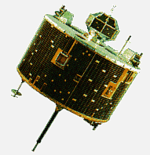- Hiten
-
For the indian soap star see Hiten Tejwani. For the game see Hiten Online.
Hiten-Hagoromo (Muses-A) 
Hiten spacecraftOperator ISAS Mission type Orbiter Satellite of Moon Orbital insertion date 19 March 1990 Orbits 10 Launch date 11:46, 24 January 1990 UTC Launch vehicle Mu-3S-II (no. 5) Mission duration 3 years, 2 months COSPAR ID 1990-007A Homepage Hiten Mass 197.4 kg The Hiten Spacecraft (Japanese pronunciation: [hiteɴ]), given the English name Celestial Maiden[1] and known before launch as MUSES-A (Mu Space Engineering Spacecraft A), part of the MUSES Program, was built by the Institute of Space and Astronautical Science of Japan and launched on January 24, 1990. It was Japan's first lunar probe, the first robotic lunar probe since the Soviet Union's Luna 24 in 1976, and the first lunar probe launched by a country other than Soviet Union or the United States.[2]
Hiten was to have been placed into a highly-elliptical Earth orbit with an apogee of 476,000 km, which would be swing past the moon. However, the injection took place with a delta-v deficit of 50 m/s, resulting in an apogee of only 290,000 km[3]. The deficiency was corrected and the probe continued on its mission.
On the first lunar swing-by, Hiten released a small orbiter, Hagoromo (named after the feather mantle of Hiten), into lunar orbit. The transmitter on Hagoromo failed, but its orbit was visually confirmed from Earth. After the eighth swing-by, Hiten successfully demonstrated the aerobraking technique on March 19, 1991. This was the first aerobraking maneuver by a deep space probe.[4] After the ninth lunar swing-by and second aero-braking maneuver on March 30, 1991, the primary mission of the probe was concluded.
First ballistic capture into lunar orbit
Edward Belbruno of the Jet Propulsion Laboratory had been working for several years on numerically modelling low-energy (weak stability boundary) trajectories. He had heard of the probe's problems and developed a ballistic capture trajectory that would enable the main probe to enter lunar orbit using zero delta-v.[5] On June 21, 1990, Belbruno faxed over an unsolicited proposal to the Japanese space agency, which responded favorably and called it an "amazing result."[6]
After the probe's primary mission had been completed, it was placed onto the Belbruno trajectory. This represented the first time that a probe had been placed into lunar orbit using zero delta-v for orbital capture.[3] On October 2, 1991, Hiten was captured temporarily into lunar orbit.
After that, it was put into a looping orbit which passed through the L4 and L5 Lagrange points to look for trapped dust particles. The only scientific instrument on Hiten was the Munich Dust Counter (MDC), and no increase over background levels was found. On February 15, 1993, Hiten was placed into a permanent lunar orbit, where it remained until it was deliberately crashed into the lunar surface on April 10, 1993 at 34°18′S 55°36′E / 34.3°S 55.6°E, between the craters Stevinus and Furnerius.
References
- ^ Uesugi, K.T. (2003). "Space Engineering Spacecraft (MUSES) Program in ISAS Featuring Its Latest Mission 'HAYABUSA'". International Conference on Recent Advances in Space Technologies, 2003. http://ieeexplore.ieee.org/iel5/9116/28908/01303961.pdf?arnumber=1303961.
- ^ "Hiten-Hagoromo Mission Profile". NASA. http://solarsystem.nasa.gov/missions/profile.cfm?MCode=Hiten. Retrieved 2007-09-14.
- ^ a b "Hiten". NASA. http://nssdc.gsfc.nasa.gov/nmc/spacecraftDisplay.do?id=1990-007A. Retrieved 2007-09-14.
- ^ "Deep Space Chronicle: A Chronology of Deep Space and Planetary Probes 1958-2000" by Asif A. Siddiqi, NASA Monographs in Aerospace History No. 24.
- ^ Fous, Jeff."From chaos, a new order" The Space Review, Monday, March 6, 2006
- ^ Belbruno, Edward. Fly me to the moon: an insider's guide to the new science of space travel. Princeton University Press, 2007.
Robotic exploration of the Moon Programs Orbiters Planned Proposed Flybys Impactors Landers Rovers S. Return Cancelled See also - Moon
- Exploration of the Moon
- Colonization of the Moon
- Manned lunar spacecraft
- List of artificial objects on the Moon
- List of current and future lunar missions
- List of lunar probes
- Apollo
- CCCP manned lunar plan
Bold italics indicates active missionsJapanese space program Organizations Weather observation CompletedHimawari (1 · 2 · 3 · 4 · 5)In operationIn orbitPlannedHimawari-8 · Himawari-9Earth observation CompletedIn operationPlannedCommunications,
broadcasting and
positioningCompletedSakura (1 · 2a · 2b · 3a · 3b) · Yuri (1 · 2a · 2b · 3a · 3b) · BS(2X · 3H · 3N) · Kakehashi · Superbird (A · A1 · B1 · A2) · JCSAT(1・2・3・R) · N-STAR (a · b) · Kirari · MBSatIn operationPlannedEngineering tests CompletedIn operationPlannedPETSAT · SDS-4CancelledSmartSat-1Private miniaturized satellites CompletedIn operationPlannedWNI satellite · Horyu (1 · 2) · SPROUT · PROITERES · TSUBAME · QSAT-EOS · SOMESAT · RAIKO · FITSAT1 · WE WISHAstronomical observation CompletedIn operationPlannedUnmanned lunar and
planetary explorationCompletedIn operationAkatsuki · IKAROSFailedNozomi · Shin'enPlannedCancelledReconnaissance CompletedIn operationIGS (Optical 1 · Optical 2 · Optical 3 · Optical 4)PlannedIGS (Experimentally Optical 5 · Optical 5 · Optical 6 · Rader 3 · Rader 4 · Rader 5 · Rader 6)Human spaceflight CompletedH-II Transfer Vehicle (1 · 2)In operationPlannedCategories:- LQ27 quadrangle
- Lunar spacecraft
- Japanese space program
- Japanese lunar exploration program
- Japanese satellites and space probes
Wikimedia Foundation. 2010.



